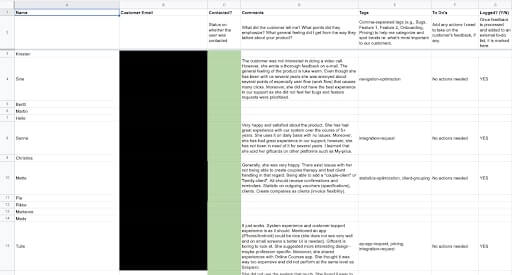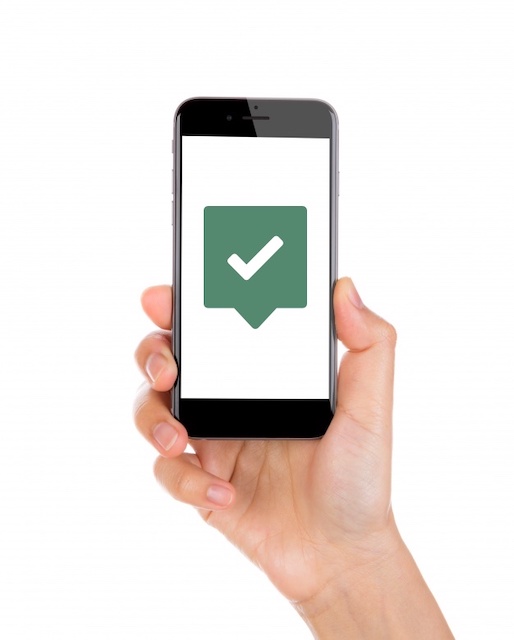Acknowledgement: I want to give credit to Alex from GrooveHQ. He was the source of inspiration for this project. Thanks, Alex!
What problem do I want to solve?
As any subscription based service, EasyPractice is interested in acquiring new customers. If our customer base does not grow, neither will EasyPractice. At least not long term.
However, growth is ambiguous. It can mean many things. And it can be measured in several ways. In this project, I wanted to take a step away from quantitative metrics. In this project, I was not interested in numbers.
Do not get me wrong, though.
I enjoy numbers. Solving problems with data is something I enjoy spending my time with. However, I am a firm believer in balance. And that goes for business development as well. Supplementing our quantitative data with qualitative. Qualitative data entails all the “softer” data points. Data points that are harder to measure.
What is qualitative data in business?
Feelings, perceptions, stories, and experiences. Just to name a few. How do you quantify a feeling? Or an experience?
It is not possible.
However, the learnings that can be derived from a conversation with a customer is just as valuable as a spreadsheet or a graph.
On a holistic note: Any project, initiative, or feature in EasyPractice needs to solve one of two things. Either we acquire new customers or we make sure existing customers enjoy EasyPractice even more.
Simple. But not easy.
Like any other military commander, I’m a big fan of having a mission statement. Or a more modern terminology would most likely be to know the problem I am trying to solve. Being aware of the problem I want solve guides me to make sure I succeed in one of the two goals EasyPractice has.
Or at least try to.
So…
What problem do I want to solve by doing customer interviews?
What is my mission statement?
I want to learn and understand the customer perspective of EasyPractice. How is EasyPractice perceived “on the outside” and how can I use that knowledge to improve our service?
In this blogpost, I would like to present how this project was carried out and the major findings I did.
Some of the findings were not surprising at all.
Others were something I never even thought about before.
I want to convey to any business that interviewing customers is doable. And the results are definitely worth it.
Let’s dive in!
How to conduct more than 3,200 minutes of interviews?
EasyPractice has long been a remote company. Online video meetings and instant messaging is in our DNA. But this is far from the case in every organisation.
A lot of bad things can be said about the corona pandemic, however, in some way it paved the way for the “digital meeting.” Inviting people to a Google Chat is no longer daring or uncommon. This made it possible for me to conduct multiple interviews in a short and efficient manner.
Win-win for both me and the kind customer that gave me some of his or her time.
To give a thorough description of how to carry out the interviews, this section will be divided into pre-interview, interview, and post-interview.
How to carry out customer interviews: Pre interview
In the introduction I said that I wanted to take a step back from spreadsheets. This was not entirely true because the first thing I did was actually to create a spreadsheet.
But, I did not use it for more than organising notes. I promise. Hang in!
Notes, tags, and to-dos from customer interviews
In this spreadsheet I had an export of every customer of EasyPractice. Then I created an overview of who I had contacted, notes from the interview, tags from the interview (we will look more at these), to-dos derived from the interview, and whether the interview was logged.

The spreadsheet provides a detailed overview in which every interview can be logged. The comment section is especially useful as you are able to write a summary after the interview. I used the comment section to note down points and bullets during the interview – but only after the interview did I write a full summary.
Doesn’t the amount of notes quickly become overwhelming?
Yes. And that is why it was important for me to convert my free text in the comments section to tags. Tags are useful to capture topics that were discussed with the customer.
Lastly, depending on the time you have available, you can determine how many customers you would like to invite for an interview. I sent between 100-200 invitations at a time and had 15% scheduled interviews from every round of invitations. However, this may vary due to multiple reasons.
The point is just to get some invitations sent! This is something you can adjust later.
Here is the email that I sent to customers:

So let’s look at this message.
It can surely be written in many different ways but I chose this very specific way for very specific reasons.
The most important thing for me was to articulate openness and genuine interest in understanding the customer’s perspective. This was not a sales call or a call with a hidden agenda.
Even before conducting the interviews, results started to emerge.
Customers who did not even want to (or have time to) do an interview with me appreciated the email.
So far, even the email is building relationships without the interview. Which is also great!
Once a date and time was agreed upon with the customer, I used Google Hangout from here on out.
Let’s look at the interview and how that was conducted.
How I did successful (and unstructured) customer interviews
I wish I had some magic set of questions to share with you. But, all my customer interviews were very unstructured. This means that I did not have any predefined questions or an agenda that I followed.
Total flexibility.
I let the interview take its own form and I let the conversation go anywhere it wanted to go.
However, there are some things to consider prior to the interview.
In these interviews, it is very important to let the customer know who you are and what this meeting is about.
This sounds very obvious but it is important to be aware of.
Furthermore, let the customer know what the overall purpose is and what you hope to get out of the interview. Here, it is crucial to be honest. For me, as the project progressed and I began to see trajectories in my data,I began to have specific things I wanted clarification on.
This needs to be aligned with the customer.
Moreover, do not forget the customer and his or her agenda. I chose to also include them by asking,
“Is there anything you need to discuss with me now that we have the chance?”
And if there was something specific, I made sure that this was covered first so I did not forget to address it.
From here, there are no rules. Be curious and genuinely interested in the experiences the customers share.
If you are very lucky you might even get criticism about your product or pricing. Something you can quickly take personally.
But put your ego in check and ask questions – even about criticism. Curious questions to an angry or upset customer due to, for example, pricing ensures your customer feels heard and you get the best feedback for your team.
And particularly criticism is a chance to grow and become better. You might not agree with the customer and the criticism you are presented with but that is not important here.
The important thing is to build the relationship and get valuable feedback for you to think about.
To end the interview I used a very specific question,
“Before we end the interview, Eric, I want to ask you if there is anything you didn’t get to mention or if there is something I did not ask that I should have asked?”
In this way, you make sure the customer is not leaving the interview with something he or she did not have a chance to bring up.
How to carry out customer interviews: Post-interview
Following the interview, write down your learnings. This needs to be done immediately after while the conversation and themes are fresh in your mind and memory.
Once your learnings and notes are archived in the spreadsheet, it is nice to follow up with the customer and thank them for their time.
Here is what I wrote:

What are the findings from 130 customer interviews?
Now to the exciting part. Results!
What impact did this have?
Was it worth it?
I think any business has started projects or taken on tasks they should not have. That is part of it.
Luckily, this was not one of those “pseudo”-projects.
It is important to remember the mission statement. I wanted to truly understand the customer perspective and learn about them and their business.
And this is something I think I accomplished. I truly got to meet our customers at EasyPractice at a much more personal level than I ever imagined.
Bettering customer relationships was the primary win for this project.
However, I also have some specific takeawaysI want to share with you.
6 specific and tangible findings from 130 customer interviews:
“I think I use a fraction of what EasyPractice offers”
EasyPractice aims to be a complete clinic management tool. Hence, the amount of solutions we have is broad. And this is mostly built upon customer feedback.
We want to be customer driven but not necessarily customer led. And that means we also say “No” to a lot of feature requests that we either do not see the value in for us or if it is too narrow to be considered valuable for all customers.
It has been like this for many years.
What I learned in this project is that the majority of EasyPractice customers only use “core functionalities.” This essentially means that many of our apps and functions are used by a minority of customers.
This was derived from interviews as I typically asked,
“How do you use EasyPractice daily?”
And then the customer would typically reply,
“I actually think I use a fraction of what your product offers currently”
The obvious great thing here is that we have a lot of customers seeing great value from EasyPractice’s core functionality.
However…
Are we properly introducing new apps and features?
“I would rather have you improve existing functionality”
This goes hand in hands with the above-mentioned observations. If the majority of EasyPractice customers value the core functionality, then optimization of those core features is considered favorable from a customer perspective.
These great learnings show the importance of not forgetting about those “old” functionalities.
The trick here is to tap into that knowledge.
What does optimisation really mean in this regard?
EasyPractice customers shared some great thoughts on this. Can some of the daily routines be automated? Can we minimise the amount of “clicks” in frequently used workflows?
This is an exciting insight for us to improve value for existing users.
“I truly value the accounting integration”
The biggest market for EasyPractice is Denmark.
This makes sense as EasyPractice was founded here and was initially built to meet the needs of Danish therapists and clinics.
Moreover, a key attribute of EasyPractice is its app-store. Here, we build our own apps but also create integrations with other systems.
And what goes hand in hand with clinic management systems?
Accounting systems!
A great insight was to see how many – and this was truly many – that actually used the external accounting software that is integrated with EasyPractice.
Could I have seen that in our database?
Yes… I could.
But talking to the customer made it possible for me to understand why this was so great.
Are there other integrations that suit therapists and clinics we could integrate with?
“Aha! I didn’t know that!”
It was both painful and valuable to learn that several customer issues or pain points could be solved with existing EasyPractice functionality.
Many customer calls turned into me providing support to the customer.
This I do not mind.
I actually learned that several customers had problems they did not know how to solve. This could be a misunderstanding of how a given application should be used. It could also be that the customer was not aware of some solutions EasyPractice already held.
How can this observation be used?
For me it is two-fold.
First, being able to solve a customer problem right then and there is truly amazing. Being completely remote and only providing email support, it is rare to share this experience with customers. When something “clicks” and just works.
Second, EasyPractice needs to improve the second-tier onboarding experience. How do we better distribute existing or new solutions and product features to our customers?
How do we create awareness without being pushy?
Key industrial insights
Through our daily customer interactions in EasyPractice customer support we receive a lot of feature requests. And we do our best to take everything to our product team who then do their best to structure and prioritise those requests.
From the interviews I learned that EasyPractice customers know a lot about their industry. Thus, the reasoning and explanation behind feature requests became more clear and I was able to have unique discussions with the customer.
But not only industry insights were presented.
I got insights into how EasyPractice was perceived by other clinicians and therapists in the industry through customer stories from Facebook forums and alike.
Obviously, I was happy to hear that we were mostly spoken well of, however, as every other company, EasyPractice is not perfect.
We also make bad decisions from time to time.
Consequently, I was able to get first hand feedback from customers on reactions and conversations between clinicians and therapists.
“Thank you so much for taking the time”
From the customer interviews I did not experience one customer who did not appreciate having the interview.
This ties back to the original purpose of this project.
Creating relationships.
Being able to hear the experiences and getting the feedback from customers was truly valuable for both them and me.
Luckily, I did not experience any customers not feeling the same way.
5 steps to work with your data
What do you do now?
You collected the data and built your relationships with your customers. Are there any ways you can squeeze more value out of this?
Here is how I worked with my data following data collection:
Step 1: Read through all your comments and summaries from your conversations. Make sure your tags align with those free text comments.
Step 2: List all used tags in a list. From here you want to structure your findings. Do this by fusioning two or more tags into one “parent tag”. Did you get a lot of feedback related to optimising several features? Consider making an “optimisation” parent tag and then have all your initial tags as child tags. Key thing is to structure your work.
Step 3: Supplement with quantitative data presentations that give you an overview. This can be done in multiple ways but it sure can help you if you can visualise how many customers you spoke with about the “X” tag. For example, I learned that optimisation was a big thing among EasyPractice users with different features. Here is my distribution:

Step 4: Communicate these learnings to your team and colleagues. What can you all make of this? Should any product-project be initiated based on this?
Step 5: I chose to incorporate this into my daily workflow. Thus, I took my proposal email and pasted it into our drip-campaign. This way, I continuously interview customers and build on my data.
Closing thoughts
Thank you if you made it this far. I hope you are inspired by this project and might see it valuable to be carried out in your company.
I would definitely recommend doing this to anyone who wants to build relationships with customers.
Obviously, the approach I chose can be optimised and several things could be discussed in terms of validity and reliability of data that was collected. I did not choose to go into too many details about this but feel free to reach out to me if you have any questions or comments about the information I wrote about here!

 alt Online scheduling
alt Online scheduling alt Create special Vouchers for your services
alt Create special Vouchers for your services alt Prague by night
alt Prague by night